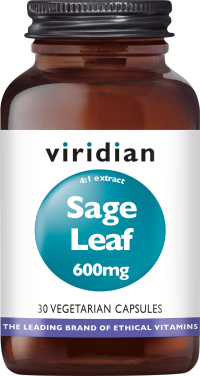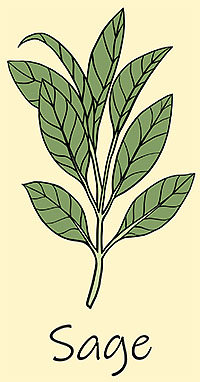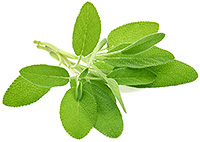
- Formula for the brain
- Contains sage, blueberry complex, ashwagandha, phosphatidylserine and uridine

- Formula for menopausal phenomena
- Contains maca, red clover and sage, among others

- Formula for menopausal phenomena
- Contains several phytoestrogens

- Contains 400 mg of sage extract per capsule
- Suitable for vegetarians and vegans

- Formula for the bones
- Contains ipriflavone, calcium, magnesium, botanicals and vitamin D3

- Corresponding to 2400 mg of sage leaf
- 2% essential oil

- Contains 400 mg of sage extract per capsule
- Standardized at 2.5% rosmarinic acid

- Certified organic
- Contains only natural ingredients

- Formula for a good mental balance
- Contains lemon balm, st. John\'s wort, dill and sage

- Formula for respiratory tract and immune system
- Contains sage, round-leaved sundew and black currant, among others

- Formula for the immune system
- Contains sage, mountain arnica and shepherds purse

- Mix of 6 classic herbs
- 2 teaspoons of syrup 3 to 5 times a day.

- Formula for support in situations of stress
- Contains lemon balm, st. John\'s wort, dill and sage
Sage is an herb used primarily for discomfort during the menopause*.
Read more or order your Salie supplements here
"Why should a man die when sage grows in the garden?"
Medieval Latin proverb
What is Sage good for?
As the Latin name suggests, sage has a wide range of uses. Sage is good for*:
* EC approval health claim(s) pending.

What is Sage (Salvia)?
Salvia (sage) is a plant genus with more than 900 species in the lipflower family (Lamiaceae) that includes plants such as thyme, lavender and rosemary.
Salvia plants prefer warmer regions with dry, sunny slopes: around the Mediterranean, in Southeast Asia and Central and South America.
Salvia officinalis (the "true" sage, also called garden sage or common sage) is an evergreen, perennial subshrub that can grow 40-80 cm tall.
Sage is well documented in traditional medicine. The beneficial effects of sage probably extend far beyond the proven health effects of its essential oils and rosemary acid. Modern extraction techniques have allowed new bioactive compounds to be extracted from the plant parts of Sage.
In addition to use in herbal medicine, Sage is used in cooking and as an ingredient in cosmetics and personal care products.
Active constituents / bioactive compounds
Sage contains vitamins, minerals, polyphenols and essential oils.
Vitamins and minerals
Fresh sage is high in vitamin C. It is also rich in vitamins A, B, K, beta-carotene, iron, calcium and potassium.
Polyphenols
More than 160 polyphenol compounds (antioxidants) have been identified in sage. Some known compounds include caffeic acid, rosemary acid and sage coumarin (phenols) and luteolin, apigenin, kaempferol and quercetin (flavonoids).
Essential oils
Plants of the genus Salvia are also rich in essential oils (terpenoids, diterpenes and triterpenes.
Long history of use: Ancient Egypt
Sage is native to the Mediterranean region and was first described around 4000 B.C. by the Egyptians who considered the plant to be highly medicinal. Traditionally, it has been used to treat various ailments, either by simply eating the plant or by making tea or a tincture from it. It was also used in the mixture for embalming and was given to pharaohs in the tomb.
Fighting the evil eye
 Sage (especially white sage) is also used in aromatherapy. Native Americans on the North American west coast used it to provide protection from the evil eye and to cleanse temples and homes of evil influences and spirits.
Sage (especially white sage) is also used in aromatherapy. Native Americans on the North American west coast used it to provide protection from the evil eye and to cleanse temples and homes of evil influences and spirits.
Greeks and Romans
Both the Greeks and Romans attributed long, healthy and even eternal life to sage. Sage (Salvia) enjoyed such high status among the Romans that in tribute to its medicinal properties, they gave it the name Salvia. This is derived from the Latin word "salvarem," meaning to save or cure. It is also reflected in the honorific title sage given in Roman times to elders who possessed great wisdom and life experience.

